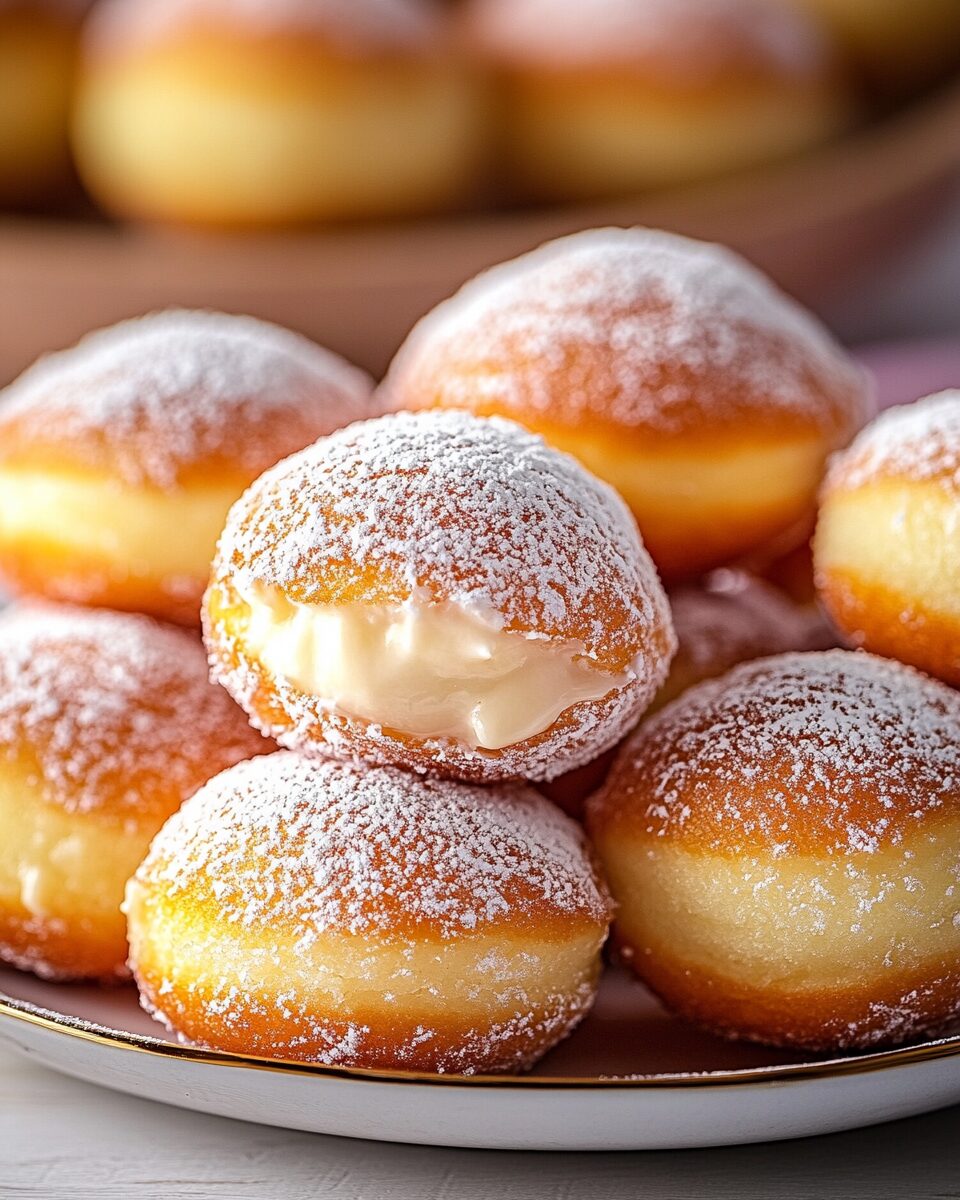Crisp on the outside, soft and airy on the inside, and filled with luscious vanilla pastry cream Bomboloni are Italy’s answer to the perfect donut. These golden, sugar-coated delights are a staple in Italian bakeries, often enjoyed with a strong espresso in the morning or as a sweet afternoon indulgence. The secret to their melt in your mouth texture lies in the delicate balance of rich dough, precise frying, and velvety filling.
Whether you fill them with classic pastry cream, silky Nutella, or fruity jam, Bomboloni are endlessly customizable and always a showstopper. Their slightly crisp sugar-dusted exterior gives way to a cloud-like interior, making each bite an irresistible moment of joy. Perfect for brunch, special occasions, or just because this homemade Bomboloni recipe brings a little taste of Italy to your kitchen.
Full Recipe:
Ingredients:
For the Dough:
-
2 cups strong bread flour (about 280g)
-
2 cups 00 flour or all-purpose flour (about 280g)
-
3 large eggs, at room temperature
-
6.5 tbsp butter (approx. 90g), softened
-
1/2 cup granulated sugar (about 100g)
-
1/2 cup lukewarm milk (about 120ml)
-
1/2 tsp vanilla paste or 1 tsp vanilla extract
-
2 1/4 tsp fast-action yeast (7g)
-
Small pinch of salt
-
2–3 tbsp caster or confectioners’ sugar (for rolling)
-
Sunflower or vegetable oil (for frying)
For the Pastry Cream (Optional Filling):
-
5 egg yolks
-
2.5 cups milk (about ½ liter)
-
1/4 cup cornstarch (about 30g)
-
1/3 cup sugar (about 70g)
-
1/2 tsp vanilla paste or 1 vanilla bean
-
Zest of 1 lemon
Directions:
Preparing the Dough:
-
In a stand mixer bowl, combine both flours, sugar, and yeast. Stir to blend.
-
Add softened butter, eggs, lukewarm milk, vanilla, and salt. Knead with a dough hook on low speed for 10 minutes until smooth and elastic.
-
Transfer the dough to a clean surface and knead a few times into a ball.
-
Place in a lightly greased bowl, cover with plastic wrap, and let it rise for 2–3 hours until tripled in size.
Shaping and Second Rise:
-
Punch down the risen dough and roll it into a rectangle about ½ inch thick.
-
Use a round cookie cutter or glass to cut circles.
-
Place dough rounds on a parchment-lined tray, cover, and let them rise for another 1–1.5 hours until tripled in size.
Frying the Bomboloni:
-
Heat sunflower or vegetable oil in a deep pot to 170°C (337°F).
-
Fry each doughnut for about 2 minutes per side until golden brown.
-
Drain on paper towels, then roll in caster or confectioners’ sugar while still warm.
Making the Pastry Cream:
-
In a bowl, whisk egg yolks, sugar, vanilla, and lemon zest.
-
Add cornstarch and whisk until smooth.
-
Heat milk in a saucepan until hot, then slowly whisk it into the egg mixture.
-
Return everything to the saucepan and cook over low heat, stirring continuously until thickened.
-
Let the pastry cream cool completely before using.
Filling the Bomboloni:
-
Make a small incision on the side of each cooled doughnut.
-
Pipe in the pastry cream using a piping bag.
-
Serve immediately or store in an airtight container for up to 2 days.
Prep Time: 20 minutes | Cooking Time: 30 minutes | Total Time: 50 minutes
Kcal: 320 kcal | Servings: 10
Bomboloni – The Iconic Italian Cream-Filled Donuts
Italy is famous for its culinary delights, from savory pasta dishes to exquisite pastries. Among the many sweet treats that Italian cuisine has to offer, Bomboloni hold a special place in the hearts of dessert lovers. These sugar-dusted, cream-filled donuts are a staple in Italian bakeries, often enjoyed with a morning espresso or as an afternoon indulgence. Soft, fluffy, and irresistibly delicious, Bomboloni are the perfect combination of airy dough and luscious filling, making them a must-try treat for anyone who loves pastries.
The Origins of Bomboloni
Bomboloni trace their roots to Tuscany, where they have been a beloved delicacy for centuries. The name “Bomboloni” comes from the Italian word “bomba,” meaning bomb, which perfectly describes their round shape and the delightful explosion of flavor when bitten into. Traditionally, these donuts were made using simple ingredients like flour, sugar, eggs, and butter, resulting in a rich yet airy dough.
While Tuscany is often credited with their invention, Bomboloni can be found in different regions of Italy, each with its own variation. In some parts of the country, they are filled with pastry cream, jam, or Nutella, while in other areas, they are enjoyed plain with just a dusting of sugar. Regardless of the filling, these donuts remain one of Italy’s most popular and cherished sweets.
What Makes Bomboloni Unique?
Unlike American style donuts that have a hole in the center, Bomboloni are completely round, resembling filled doughnuts rather than ring shaped ones. They are fried to golden perfection, giving them a light crispiness on the outside while remaining soft and airy on the inside.
One of the most exciting aspects of Bomboloni is the filling. While classic vanilla pastry cream is the most traditional, many modern variations have emerged, including:
-
Nutella Bomboloni: A chocolate-hazelnut delight
-
Custard-filled Bomboloni: With thick, creamy custard inside
-
Fruit-filled Bomboloni: Stuffed with raspberry, strawberry, or apricot jam
-
Ricotta Bomboloni: A Sicilian-inspired version with ricotta cheese
The dough itself is slightly richer than other donut recipes because it often includes eggs, butter, and sometimes milk, creating a tender and flavorful base. This richness, combined with the lightness of the yeast dough, gives Bomboloni their signature fluffy texture.
When Are Bomboloni Eaten in Italy?
Bomboloni are versatile and can be enjoyed at any time of the day. However, they are most commonly eaten:
-
For breakfast – Italians love a sweet start to the day, often pairing Bomboloni with a cappuccino or espresso.
-
As an afternoon treat – They are popular as a merenda (afternoon snack) enjoyed with a cup of tea or coffee.
-
During festivals and holidays – Bomboloni are commonly found at street fairs, bakeries, and festivals throughout Italy, especially during Carnevale.
In coastal regions like Rimini and Versilia, Bomboloni are sold at beachside kiosks, making them a popular summer treat enjoyed by tourists and locals alike.
The Art of Frying Bomboloni
One of the key secrets to making perfect Bomboloni is frying them at the right temperature. The oil should be heated to 170-180°C (340-360°F) hot enough to create a crisp outer layer while allowing the inside to cook evenly. If the oil is too hot, the outside will burn before the inside is fully cooked. If it’s too cool, the Bomboloni will absorb too much oil and become greasy.
A well-made Bomboloni should be:
-
Golden brown on the outside with a thin, crispy shell
-
Light and fluffy on the inside with a delicate, airy structure
-
Not overly greasy, with a soft, melt-in-your-mouth texture
After frying, they are immediately rolled in fine sugar, which adheres to the warm surface and gives them their signature sweetness. Some variations even use cinnamon sugar or powdered sugar for an extra layer of flavor.
Why You Should Try Making Bomboloni at Home
While Bomboloni are widely available in Italian bakeries, making them at home is an experience every baking enthusiast should try at least once. Here’s why:
-
They taste freshest when homemade – Nothing compares to biting into a warm, freshly fried Bomboloni straight from the kitchen.
-
You can customize the filling – Whether you love classic pastry cream, rich chocolate, or fruity jam, you can experiment with different fillings to suit your taste.
-
It’s a fun baking project – The process of making Bomboloni, from kneading the dough to frying and filling them, is rewarding and enjoyable.
If you’re intimidated by deep frying, don’t worry! It just takes a little practice to get the oil temperature right. Plus, the joy of creating homemade Bomboloni is well worth the effort.
How to Serve Bomboloni
Bomboloni are best enjoyed fresh and warm, but they can also be stored in an airtight container for up to two days. Here are some ways to serve them:
-
With coffee – A classic Italian pairing with espresso or cappuccino.
-
With gelato – Some dessert shops in Italy serve Bomboloni sliced open with a scoop of gelato inside.
-
Drizzled with chocolate – A touch of melted dark or white chocolate can make them even more indulgent.
-
As a special breakfast – Serve them alongside fresh fruit and a dusting of powdered sugar.
For those who love trying new flavors, consider experimenting with different fillings such as pistachio cream, lemon curd, or even salted caramel for a modern twist on this traditional treat.
Conclusion
Bomboloni are more than just a delicious treat they are a symbol of Italian bakery culture and a reminder of the simple joys of homemade sweets. Whether enjoyed at a café in Florence, a beachside stand in Rimini, or freshly made in your own kitchen, these light, fluffy, and creamy filled donuts offer an unforgettable taste experience.
Making Bomboloni at home allows you to capture a little piece of Italy, bringing warmth and indulgence to your table. With a perfect balance of sweetness, crispness, and creaminess, they are a crowd pleaser for any occasion. Whether you’re a seasoned baker or a beginner in the kitchen, this recipe is one you’ll want to keep in your collection and share with loved ones.






